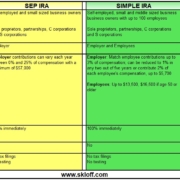Top 10 Medicare Tips – 09/01/18
Money Matters – Skloff Financial Group Question of the Month – September 1, 2018
By Aaron Skloff, AIF, CFA, MBA
Q: We read your article titled ‘Medicare Basics – What You Need to Know’. Can you provide us the top 10 Medicare tips?
A: The Problem — Understanding Medicare Basics Will Only Take You So Far
Enrolling and maintaining health insurance requires ongoing research. With ever changing costs, deductibles and copays, you can’t rely solely on Medicare to educate you.
The Solution — Understanding the Top 10 Medicare Tips
The following top 10 Medicare tips can help save you money, avoid expected expenses and highlight where Medicare just falls flat on its face.
1. Know What Medicare Does Not Cover. In addition to Medicare’s guide titled ‘Items and Services Not Covered Under Medicare’, knowing specific examples is always helpful. Medicare does not cover dental expenses, such as a $5,000 tooth implant. While Medicare may pay for a hearing test if your doctor orders it, Medicare usually does not pay for hearing aids. A single hearing aid can cost $3,000.
2. Purchase Long Term Care Insurance. When it comes to long term care, Medicare falls flat on its face. Medicare does not cover long-term care services, with limited exceptions for a brief period. Since 7 in 10 people over the age 65 will require long term care and the cost of care can be staggering, purchase long term care insurance.
3. Avoid the Part A Late Enrollment Penalty. If you are not eligible for premium-free Part A, and you do not buy it when you are first eligible, your monthly premium may go up 10%. You will have to pay the higher premium for twice the number of years you could have had Part A but did not sign up.
4. Avoid the Part B Late Enrollment Penalty. In most cases, if you do not sign up for Part B when you are first eligible, you will have to pay a late enrollment penalty. You will have to pay this penalty for as long as you have Part B. Your monthly premium for Part B may go up 10% for each full 12-month period that you could have had Part B but did not sign up for it.
5. Avoid the Part D Late Enrollment Penalty. You may owe a late enrollment penalty if, for any continuous period of 63 days or more after your Initial Enrollment Period is over, you go without: a Medicare Prescription Drug Plan (Part D), a Medicare Advantage Plan (Part C), another Medicare health plan that offers Medicare prescription drug coverage or a creditable prescription drug coverage. Medicare calculates the penalty by multiplying 1% of the “national base beneficiary premium” ($35.02 in 2018; $33.19 in 2019) times the number of full, uncovered months you did not have Part D or creditable coverage.
6. Avoid a Medigap Denial or Enrollment Penalty. The best time to buy a Medigap policy is during your 6-month Medigap open enrollment period, the month you are 65 and enrolled in Medicare Part B. During that time, you can buy any Medigap policy sold in your state, even if you have health problems. After this enrollment period, you may not be able to buy a Medigap policy. If you can buy one, it may cost more.
7. Read Your Medicare Advantage Plan Annual Notice of Change (ANOC). The ANOC must be sent by September 30 to participants and includes any changes in coverage, costs, or service area that will be effective in January. Fall Open Enrollment occurs each year from October 15 through December 7. During this period, you can make changes, including: switching from Original Medicare to a Medicare Advantage plan, or vice versa, switching between Medicare Advantage plans and Medicare Prescription Drug Plans, and if you did not enroll in Medicare Part D coverage when you were first eligible, you can do so.
8. Use Medicare Plan Finder. Medicare’s website offers the Medicare Plan Finder tool. It allows you to view and compare all available drug and health plans, decide on a plan and enroll in a plan.
9. Contact Your State Health Insurance Assistance Program (SHIP). Your SHIP may pay a portion of your Medicare premiums through the Medicare Savings Program. Eligibility is based on income and resources.
10. Save on Drug Costs. If you meet certain income and resource limits, you may qualify for the federal Extra Help from Medicare to pay the costs of Medicare prescription drug coverage.
Action Steps
Since there are various enrollment deadlines and penalties if those enrollment deadlines are not met, conduct your research well before your deadline. Evaluate what parts to enroll in based on your unique needs. Protect yourself where Medicare falls flat on its face.
Aaron Skloff, Accredited Investment Fiduciary (AIF), Chartered Financial Analyst (CFA), Master of Business Administration (MBA) is CEO of Skloff Financial Group, a Registered Investment Advisory firm. He can be contacted at www.skloff.com or 908-464-3060.












